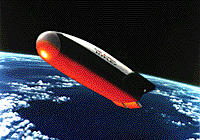 Artist's concept of HYFLEX
Artist's concept of HYFLEX
The National Space Development Agency of Japan and the National Aerospace Laboratory of the Science and Technology Agency recently developed an experimental hypersonic flight vehicle that can reach speeds of Mach 15. Called the HYFLEX (Hypersonic Flight Experiment), the experimental vehicle went on show to the media from the middle of May. The aim of the experimental vehicle, which is scheduled to be put into flight at an altitude of 110 kilometers and retrieved after splash down in the sea at the beginning of 1996, is to provide necessary data for the design of a Japanese-made space shuttle. Called HOPE, this shuttle prototype is scheduled to be completed in fiscal 1999 (April 1999 to March 2000).
The HYFLEX measures 1.04 meters in height and 4.40 meters in length, weighs about one ton, and has small lateral stabilizing fins. Although it has no propulsion unit, the HYFLEX can adjust its position and direction. Its body surface is covered with C/C (carbon-carbon composite) and ceramic tiles, allowing it withstand the immense heat when reentering the atmosphere.
According to plans, HYFLEX will be launched on a newly developed J-I rocket from the space center on Tanegashima Island in Kyushu in January or February 1996 and separated at a height of 110 kilometers above the earth. The HYFLEX then will travel at a maximum speed of Mach 15, will reenter the atmosphere at a maximum angle of 49 degrees, and will be retrieved from the Pacific Ocean near the Ogasawara Islands. The collected data on such factors as the experimental vehicle's flight path upon descent and the body's heat resistance against temperatures of up to 1,500 degrees Celsius will then be used in the design of HOPE.
One of the special features of HYFLEX is that, like an airplane, it has lifting power and can fly; less heat will be created through the atmosphere than in the case of capsule-shaped spacecraft. Space development personnel and observers have high expectations of the experimental vehicle as a first step toward the development of HOPE, which is scheduled to fly back and forth between the earth and space.
(The above article, edited by Japan Echo Inc., is based on domestic
Japanese news sources. It is offered for reference purposes and does
not necessarily represent the policy or views of the Japanese
Government. )